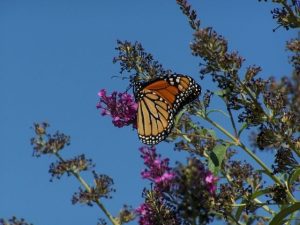As the calendar year draws to a close, hopefully we can find time to reflect on things for which we can be grateful. Following is a short list of some of my “gardening gratitudes” for 2015:
1. Rain and snow. With the forecast of El Nino conditions for early 2016, I’m thrilled with the rain and snow we’ve already received to date. The soil in my backyard is moist. Leaves on the ground are helping hold moisture. Vegetation is beaded with water drops in the morning. Bags of leaves that my neighbor donated to my compost pile are heavy with moisture. That pesky Bermuda grass that insists on crawling into my vegetable garden is easier to remove from damp soil. Shoots of miner’s lettuce, Claytonia perfoliata, are coming up everywhere. Hurray for winter salads!
2. Drip irrigation. Having a low-water-use source of irrigation on a timer allowed my vegetable garden to flourish while I was gone from California for much of the spring and summer. That same drip irrigation allowed the growth of giant zucchinis that added moisture and flavor to unconventional cornbread and cookie recipes. It also fueled the growth of tomato plants whose fruits, harvested just before frost set in, are still ripening on the window sill. For this bounty – when I wasn’t even around to provide that proverbial fertilizer of the “gardener’s shadow” – I am extremely grateful!
3. Toyon, Heteromeles arbutifolia, is a California native plant that, known as Christmas berry and California holly, grew so thickly on the hills of Southern California that it gave Hollywood its name. (Check out Philip Rundel and Robert Gustafson’s 2005 field guide “Introduction to the Plant Life of Southern California: Coast to Foothills” for the story.)It grows as a member of the coastal scrub, chaparral and oak woodland communities. I think of it as growing as an understory shrub in hot, dry foothill areas up to about 3000 feet in elevation, but on a recent weekend trip to the Santa Cruz coast I was delighted to see it growing alongside highways in the area.
Since toyon is a California native, it’s well-adapted to life without supplemental water. In the spring it provides delicate white flowers. And in the winter it highlights those lovely evergreen leaves with bright red berries. It provides cover and food for wildlife – birds use the berries as a source of winter food. What’s not to like about this wonderful plant?
4. Monarch butterflies. Several years ago, a fellow Master Gardener gave me a sampling of several plants from her garden that grew out a narrow leaf milkweed, Asclepias fascicularis. Over the years, I’ve carefully protected the milkweed plants where they’ve chosen to grow and now have three or four small patches of the plants in my backyard. Imagine my delight when I saw, on more than one occasion this summer, a Monarch butterfly drift through my yard and explore the plants, sampling nectar from the milkweed flowers.
On that same recent trip to Santa Cruz County, my hostess treated me to a trip to Natural Bridges State Park where a grove of eucalyptus trees host overwintering monarchs. What a pleasure to watch them flitting through the air and coming to land in their hanging clusters on the tree branches. If my tiny patches of milkweed are able to assist those four-generation migrations of such gorgeous creatures, I’m grateful!
Enjoy your own reflections on good gardening memories from 2015; here’s to gardening success in the New Year.
Rebecca Miller-Cripps is a University of California Cooperative Extension Master Gardener of Tuolumne County who is also grateful that her garden is a National Wildlife Federation Certified Wildlife Habitat providing food, water, cover and nesting places with sustainable gardening practices.


